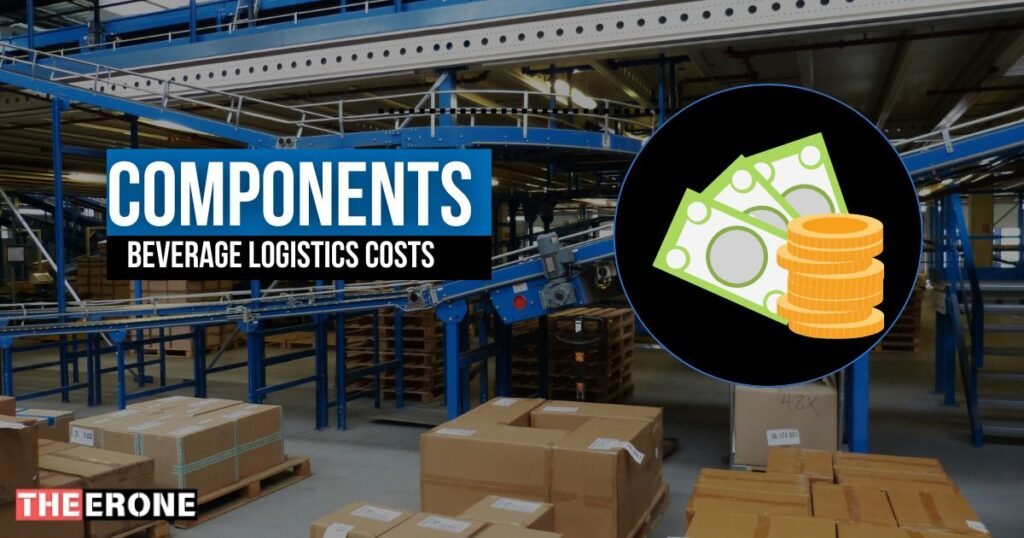Logistics is crucial for efficiently transporting drinks from factories to customers. It involves transporting, storing, and packing beverages using advanced technology. Proper logistics help reduce costs while maintaining drink quality and competitiveness. Logistics costs significantly affect overall expenses and determine product pricing in the market.
Businesses gain a competitive edge by thoroughly understanding these logistics-related costs. Improved logistics enable better decision-making, increased profits, and enhanced customer satisfaction.
Therefore, mastering logistics is critical to success in the beverage industry.
We will learn each and every point about How Much is Logistics in Beverages?
Understanding Logistics Costs in the Beverage Industry
Logistics costs in the beverage industry include various essential operations. These costs encompass transportation, warehousing, and handling activities. Transportation costs cover fuel, vehicle maintenance, and driver wages. Warehousing involves rent, utilities, and security expenses.
Handling costs account for labor, equipment, and operational processes. Each category significantly affects the final product price.
Efficient management of logistics costs ensures product affordability and profitability. Understanding these expenses enhances decision-making and customer satisfaction. Companies should analyze and reduce logistics costs effectively. The goal is to streamline operations for competitive pricing and improved service.
What is Logistics in Beverages?
Logistics in beverages involves efficiently moving drinks from production to customers. These operations include transporting, warehousing, and packing drinks using technology. Logistics ensures that beverages maintain quality throughout the supply chain process.
Proper logistics reduce costs and maintain competitive pricing in the market. Transport routes are planned carefully for timely and cost-effective deliveries. Storage facilities ensure that drinks are kept at optimal conditions for quality. Packaging protects beverages and enhances their appeal to customers.
Collectively, these tasks help maintain brand reputation and customer satisfaction. Understanding logistics is essential for success and growth in the beverage industry. Effective logistics provide a strategic advantage and improve operational efficiency.
Why Understanding Logistics Costs Matters?
Understanding logistics costs is crucial for success in the beverage industry supply chain. These costs directly influence product pricing and overall business profitability. Transportation, storage, and packaging are critical components affecting logistics costs. Managing these costs well helps keep businesses competitive in the market.
Efficient logistics solutions can significantly improve companies’ profit margins. They also minimize supply chain disruptions, ensuring timely product delivery to customers. Knowledge of logistics costs aids in making informed business decisions. Accurate cost management ensures products remain affordable for consumers, maintaining customer trust.
Businesses should regularly analyze their logistics operations for cost-reduction opportunities. Improved logistics lead to enhanced customer satisfaction and business growth. Understanding logistics costs prepares companies for future market challenges effectively.
You can also explore: What Are Two Benefits Associated with Reverse Logistics?
Key Components of Beverage Logistics Costs

Transportation Costs
Road transportation is expected due to its flexibility and regional coverage. Rail transportation is cost-effective for bulk beverages over long distances. Sea transport is optimal for international shipments, considering longer transit times. Air freight is the fastest but most expensive transportation method available.
Distance directly impacts transportation costs due to fuel consumption and labor hours. Managing a fleet involves tracking vehicle maintenance and optimizing delivery routes for efficiency.
Warehousing Costs
Storing beverages requires special facilities to maintain appropriate temperature control conditions. The warehouse location affects costs because of accessibility and local rental expenses.
Facility type impacts costs, with automated systems generally more expensive but efficient. Duration of storage matters because longer stays mean higher warehousing fees.
Packaging and Handling Costs
Beverage packaging requires durability to protect products during transportation and storage. Specialized packaging needs affect costs and require careful planning and innovation.
Handling involves labor costs for loading, unloading, and quality checks. Machinery aids in packaging but requires investment and regular maintenance expenses.
Inventory Management Costs
Inventory management involves tracking stock levels to efficiently meet customer demand. It also includes costs for software, technology, and staff overseeing stock levels. Inventory shrinkage impacts costs due to loss from damage, theft, or misplacement. Spoilage can significantly increase costs if perishable beverages exceed their shelf life.
Additional Factors Impacting Logistics Costs in Beverages
Seasonal Demand Fluctuations
Seasonal demand changes can significantly alter logistics costs throughout the year. High-demand periods require businesses to increase their transportation and storage capacity. Companies often hire additional workers during peak seasons to handle increased orders effectively.
Logistics expenses rise as companies need more packaging and handling during busy times. In low-demand periods, excess stock might increase warehousing costs and affect profitability.
Regulatory and Compliance Costs
In the beverage business, regulatory compliance greatly impacts logistical costs. Companies must follow strict food safety regulations to guarantee the quality and safety of their products. Transportation restrictions frequently require businesses to utilize certified cars and drivers with the necessary training.
Complying with packaging regulations demands investment in suitable materials and labeling processes. Regulatory fines can occur if companies fail to meet established compliance standards.
Technology and Automation Investments
Investing in logistics technology can raise upfront expenses while increasing efficiency. Businesses employ tracking systems to monitor shipments and increase the precision of deliveries.
Automation in warehousing can increase operational efficiency and lower labor expenses. Staff training and system adaptation are necessary when implementing technological solutions. The technology’s long-term advantages include fewer mistakes and quicker processing times.
Strategies to Optimize Beverage Logistics Costs

Route Optimization and Efficient Transport Planning
Reducing fuel consumption is vital when optimizing transportation routes effectively. Plan delivery routes carefully to prevent unnecessary backtracking during transport. Use route optimization software to calculate the fastest paths for deliveries. Regularly update routes to accommodate changing road conditions or construction work. Establish communication channels with drivers for real-time route adjustments when needed.
Leveraging Technology for Inventory Management
Implement inventory management software to monitor stock levels accurately in real-time. Use technology to track expired products and reduce waste efficiently.
Automation helps reorder stock promptly, preventing shortages and excess inventory costs. Integrate software with sales data to predict future demand trends precisely. Optimize storage space utilization through inventory software to reduce warehousing expenses.
Sustainable Packaging Choices
Select environmentally friendly packing materials to save money and protect the environment. Lightweight packing lowers shipping costs because it requires less weight for transit. Customers seeking ecologically friendly and sustainable products are drawn to biodegradable solutions.
Examine packaging sources for sustainable, long-lasting, and reasonably priced material solutions. Recycled materials can improve the brand’s image and reduce packaging expenses.
Outsourcing and Third-Party Logistics (3PL)
When internal logistics lack capacity or efficiency, think about using 3PL services. Please use outside suppliers to take advantage of their experience and existing networks.
Staffing, warehousing, and transportation costs can all be reduced through outsourcing. Before committing, consider the 3PL provider’s resources, experience, and dependability. Examine the effectiveness and affordability of the 3PL services you use regularly.
Calculating and Forecasting Logistics Costs
Businesses can more efficiently control their distribution costs by better understanding logistics costs. Determine all the costs connected with your logistics, including handling, warehousing, and transportation. Include small costs like insurance, packaging, and regulatory compliance in the total cost calculation.
Apply the straightforward formula:
Total Logistics Cost = Transportation Costs + Warehousing Costs + Handling Costs + Additional Costs.
Calculate costs per unit to understand logistics expenses for each product shipped. Forecasting logistics costs helps companies budget and plan future expenses efficiently. Accurate forecasts prevent financial surprises and ensure steady business operations and cash flow. Historical data and market trends help predict future logistics costs accurately.
Anticipate seasonal demand changes to adjust logistics strategies and budget accordingly. Develop a precise budget to allocate resources where needed in logistics operations. Regularly update forecasts as conditions or business goals change over time.
Using technology like software systems enhances accuracy in calculating and forecasting logistics costs. Accurate cost management strategies significantly impact profitability and business growth.
Conclusion
Many factors impact logistics costs in the beverage industry. Efficient logistics are crucial for business success. Effective transport planning reduces fuel consumption and saves money. Technology aids inventory management and significantly decreases wastage. Sustainable packaging attracts eco-conscious consumers and cuts shipping costs. Outsourcing logistics operations boosts efficiency and minimizes expenses.
Businesses gain from using technology to forecast logistics costs precisely. Companies should invest in cost-effective logistics for greater profitability. Efficient logistics significantly enhance customer satisfaction and loyalty. By optimizing logistics, companies improve their financial performance overall.
FAQs
How do you calculate logistics costs?
Calculate logistics costs and add up transportation, warehousing, and handling expenses. Also include insurance, packaging, and compliance costs. Remember to consider these more minor expenses, as they can add up. This comprehensive approach ensures you capture all relevant costs. Regular review and adjustments help maintain accuracy.
What are the total logistics costs?
Total logistics costs include all expenses related to product distribution, including transportation, warehousing, and handling. Packaging and compliance costs are also included. Total costs give a complete picture of logistics spending, which helps with budgeting and cost control.
What is the common cost in logistics?
Common costs refer to shared logistics expenses across products. These can include shared warehouse operations. Other examples are transportation costs for multiple items. Identifying common costs helps in fair expense distribution. This insight ensures accurate cost management.
What is the cost of serving in logistics?
Cost to serve measures expenses for delivering products. It includes transportation, handling, and customer service. Each service adds to the total cost. It is understanding the cost to serve aids in pricing and profitability. Use this data for better decision-making.
Why should I forecast logistics costs?
Forecasting anticipates future logistics expenses. It helps in budgeting and resource planning. Predicting costs prevents financial issues and surprises. Accurate forecasts enhance business stability. Technology can improve forecast accuracy, ensuring effective logistics strategies. Regular updates keep forecasts reliable.












